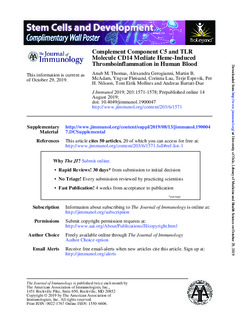| dc.description.abstract | Heme is a critical danger molecule liberated from hemeproteins in various conditions, including from hemoglobin in hemolytic diseases. Heme may cause thromboinflammatory damage by activating inflammatory and hemostatic pathways, such as complement, the TLRs, coagulation, and platelets. In this study, we explored the effect of single and dual inhibition of complement component C5 and TLR coreceptor CD14 on heme-induced thromboinflammation in an ex vivo human whole blood model. Heme induced a dose-dependent activation of complement via the alternative pathway. Single inhibition of C5 by eculizumab attenuated the release of IL-6, IL-8, TNF, MCP-1, MIP-1α, IFN-γ, LTB-4, MMP-8 and -9, and IL-1Ra with more than 60% (p < 0.05 for all) reduced the upregulation of CD11b on granulocytes and monocytes by 59 and 40%, respectively (p < 0.05), and attenuated monocytic tissue factor expression by 33% (p < 0.001). Blocking CD14 attenuated IL-6 and TNF by more than 50% (p < 0.05). In contrast to single inhibition, combined C5 and CD14 was required for a significantly attenuated prothrombin cleavage (72%, p < 0.05). Markers of thromboinflammation were also quantified in two patients admitted to the hospital with sickle cell disease (SCD) crisis. Both SCD patients had pronounced hemolysis and depleted plasma hemopexin and haptoglobin. Plasma heme and complement activation was markedly increased in one patient, a coinciding observation as demonstrated ex vivo. In conclusion, heme-induced thromboinflammation was largely attenuated by C5 inhibition alone, with a beneficial effect of adding a CD14 inhibitor to attenuate prothrombin activation. Targeting C5 has the potential to reduce thromboinflammation in SCD crisis patients. | nb_NO |
